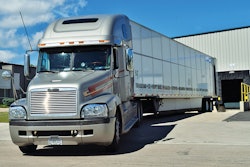PARTNERS IN BUSINESS TABLE OF CONTENTS »
It’s expensive to switch carriers, so pick your partner carefully if running leased
The increased revenue that can come from changing carriers is easy to understand, but the cost involved in making that switch often is overlooked. It can be thousands of dollars. And when you look closer at revenue and costs instead of just pay per mile, net income often isn’t any better at a different carrier.
Choosing a carrier should be approached systematically. First search for carriers that pull the kind of freight and run in the geographic area that interests you. List as many potential carriers as possible.
Most people will try to find one name that fits all the preferred criteria. Take the opposite approach. Pick a name on the list and start looking for a reason not to choose that one. Maybe the company requires more experience than you have or requires a newer tractor.
When you find a carrier you can’t eliminate, put it on your short list. When you reach five, follow these steps:
- Contact the carriers directly. Request a copy of their lease agreement. Read each lease from front to back and make notes. Lists things you like and don’t like about the lease and things you don’t understand. If they can’t or won’t send a lease agreement, scratch them off the list.
- Call each carrier again. You need to make sure you understand everything and how cooperative the carrier is. If you can’t get straight answers about the lease now, odds are you’ll have the same obstacles if you decide to work with that carrier. In most cases, these conversations will get your list down to two or three.
- Schedule a visit to each company. If there are multiple locations, visit corporate headquarters. It might be expensive and time-consuming, but you are trying to eliminate needless risks as you design your business.
- Request a visit with someone in each department you would deal with as a leased owner-operator. If they don’t have time for you now, do you think they will have time for you after you sign the lease?
- Prior to your visit, write down questions for each department, such as dispatch, safety and compliance, operations and settlement.
These steps will prepare you well for getting the critical information you need. Once you’ve done so, the business-minded approach you’ve demonstrated will help establish you as a professional who deserves respect.

QUESTIONS TO ASK OF PROSPECTIVE CARRIERS
PAY. Ask if fuel surcharges are available and if they are packaged with base pay or paid separately. Check whether the fuel surcharge is nationwide or regional and what miles-per-gallon rate the surcharge is based on – 6 mpg is common (see Chapter 5). Confirm that 100 percent of the surcharge is passed to owner-operators.
Ask if the carrier offers layover pay, empty mile compensation and pay for loading and unloading, or reimbursement for lumper charges. Do they reimburse for tolls? Do they pay your fuel taxes, or are they charged back to you? When are settlements paid?
Does the carrier impose chargebacks? Ask about paying for liability insurance or onboard fleet management systems such as electronic logging devices or tracking systems.
Hourly pay for time spent waiting at shipper and receiver locations (detention) is increasingly important — and prevalent — as carriers have been required to switch to ELDs. Does the carrier offer pay for detention? Does it guarantee that pay regardless of whether it’s collecting it from the shipper/receiver?
While that increasingly is the case, old practices survive at many carriers. Many of those businesses have moved in the direction of time-based pay systems with hourly detention-pay plans, often billed after one or two free hours, though some research suggests that up to half of the industry’s drivers get little, if any, detention pay.
Independent owner-operators running under their own carrier authority bill direct shippers as much as $70-$100 hourly for excessive detention; it’s unlikely you’ll get such rates from your carrier as a leased operator.
Home time. In assessing routes, loads and miles, ask if certain routes or regions are open that would accommodate your desired amount of home time. Make similar inquiries about specialized work such as heavy-haul or high-touch loads. Ask carriers about available miles and routes, and question their operators about the miles they’re getting.
CULTURE. As with people, companies have personalities. Some carriers will want to control everything you do, and others will give you plenty of rein. Some companies provide limited benefits to owner-operators, such as fuel networks and insurance assistance. Don’t overlook possibilities at small carriers, particularly if you’re looking for more operational freedom. Some prominent larger all-owner-operator carriers likewise operate with a maximum of load, route and schedule choices for the majority of their drivers.
PHILOSOPHY. Does the carrier’s way of doing business match yours? Ask whether company drivers get dispatched before owner-operators, or whether company drivers get better loads. Even owner-operators who work for the same company can get significantly different pay; the difference can be as much as 30 cents per mile. Would you be in the carrier’s top tier – or bottom tier?
You usually can survive one switch in a year, though it’s difficult. Switching twice in a year could put you out of business. If you have a good relationship with your driver manager, enjoy the company’s culture and have opportunities to get the miles and pay that you need, then chances are you won’t be better off anywhere else.
EVALUATING CARRIER COMPENSATION
Recruiting ads call out to you from trucking magazines and websites offering diverse pay and benefits. With so many carriers recruiting owner-operators and so many factors to consider within each pay package, it’s no wonder drivers have a tough time estimating potential revenue and net income from advertised compensation packages.
While comparing pay packages is a time-consuming, often frustrating endeavor, the key is to start with an understanding of how much you need to make each month to cover your expenses. Only then will you know whether a carrier’s pay package is a good deal for you.
Figure your total cost per mile by adding fixed and variable costs for the year and dividing by 12 to get the average per month. Then divide that number by average monthly miles to determine your cost per mile for a given month. This will be what you will need to make monthly just to break even.
Be sure to include nonrevenue miles, such as deadhead or a trip to the shop, in your monthly estimate. Those miles also cost money.
If a company agrees to pay you a dollar per mile for deadhead but it costs you $1.10 to operate the truck, you’ll have to make up that lost 10 cents per mile elsewhere.
Profit margin (net income as a percentage of total revenue) for independent owner-operators without a carrier partner hovers at about 40 percent for owner-operators who do not include pay to themselves as a business expense, such as in an S Corp arrangment.
In your evaluation of compensation, you ideally want to beat the averages. Overdrive research in 2016 showed that more than 40 percent of owner-operators try to hit a profit margin target above 40 percent.
For some elements of a pay package, such as detention pay, it’s also helpful to know your revenue per hour of driving. To determine this, multiply your per-mile rate by your average driving speed. For example:
Pay rate per mile: $1.10
Average speed x 59 mph
GROSS REVENUE PER HOUR = $64.90
Knowing your hourly rate helps you determine whether the detention pay you’re offered adequately compensates you for the revenue you lose sitting on a load.
Use your break-even point and your hourly revenue estimate as you begin to gather information about pay packages. Ask carriers detailed questions about all revenue items and any cost items they cover or help cover. Chart those numbers on a spreadsheet to begin your evaluation. To make your comparisons as accurate as possible, make sure you understand some of the more confusing aspects of pay packages:
LEARN HOW MILEAGE IS CALCULATED. If a carrier pays by the mile, ask which system is used. Short miles give the shortest route, so they are the least desirable to an owner-operator.
Practical route miles average 3 percent to 5 percent more. Hub miles average 3 percent to 5 percent more than practical route miles, but few carriers use that system.
Many fleets have switched from short to practical miles, which amounts to an across-the-board raise. Practical miles systems use measurements based on actual addresses or ZIP codes and account for common-sense alternate routing.
Fleets won’t pay drivers the practical rate unless they know their customers also will pay the practical rate. Ask a prospective fleet whether its rate paid to drivers matches its rate charged to customers. Also ask what routing system the fleet uses.
You can run your own comparisons with programs such as Rand McNally’s Milemaker (www.randmcnally.com/product/milemaker), Prophesy Mileage and Routing (www.mile.com), ProMiles (www.promiles.com) or ALK’s PC Miler (www.pcmiler.com).
Some fleets also offer mileage pay that varies according to the haul’s length, generally paying more per mile for shorter hauls. Ask prospective carriers about their particular variations.
LEARN HOW PERCENTAGE OF REVENUE IS CALCULATED. If a carrier pays by percentage, understand the calculations. Some carriers may pay 78 percent of 100 percent of the load’s all-in revenue. Others pay 78 percent of 96 percent of the revenue, or 90 percent of 100 percent with added cost responsibility for the operators. Such distinctions can account for hundreds of dollars’ difference over 10,000 miles.
LEARN THE POLICY AND PRACTICE OF FUEL SURCHARGES. Find out exactly how the surcharge is computed and whether it compensates for all or only part of rising diesel prices. The best-case scenario is a carrier that bills surcharges to all clients and pays all surcharges to the owner-operator. If the carrier pays only on collection, ask for the average amount passed on to owner-operators, and use that number to make your comparison.
LEARN THE REAL COST OF ANY CO-OP PROGRAM. If you plan to make use of a carrier’s cooperative buying program, ask what the markup is on things such as tires. Ask how quickly the purchase has to be repaid.
Make sure you’re getting a good deal. Some carriers with fuel programs charge owner-operators $1 to $3 every time they use the fleet’s fuel card, which can add up to hundreds of dollars per year. On the flipside, buying fuel at a cheaper rate could more than make up for those fees. Crunch the numbers to find out.
Download the entire Partners in Business Manual
Chapter 1: Becoming your own boss
Chapter 2: Bookkeeping and business analysis
Chapter 3: Understanding your revenue and costs
Chapter 5: Controlling fuel costs
Chapter 6: Controlling tire costs
Chapter 8: Income tax and other taxes
Chapter 9: Choosing a business structure
Chapter 10: Truck buying, leasing, financing
Chapter 11: Choosing a trailer
Chapter 12: Maintaining your equipment
Chapter 13: Choosing a carrier
Chapter 14: Computers, mobile devices and the internet
Chapter 15: Staying compliant and safe
Chapter 16: Trucking insurance













